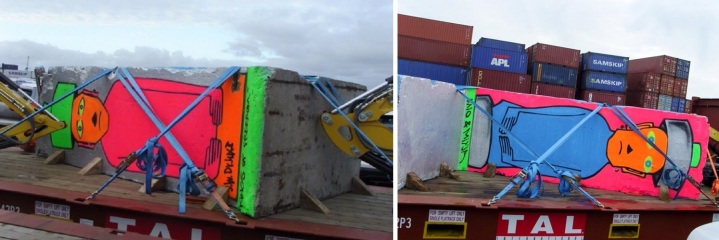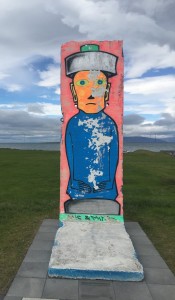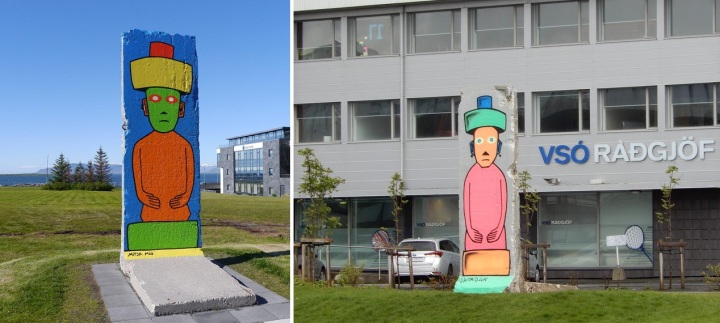Since the night the wall came down – in November 1989 – pieces of the Berlin Wall have travelled far and wide. Over forty countries now host sections of the wall, from Italy and the Vatican to Singapore and South Africa. Along Wilshire Boulevard in Los Angeles, several sections face out onto the Los Angeles County Museum of Art, in an installation arranged by the nearby Wende Museum of the Cold War; while Jamaica received a portion in 2010 as a gift to record-breaking sprinter Usain Bolt; and the Ronald Reagan Presidential Library and Museum in Simi Valley, California holds a piece of the wall given to the former US President the year after it was dismantled.
In October 2015, Iceland became the latest country to welcome a segment of the Berlin Wall. To mark the 25th anniversary of German reunification in 1990, this concrete block was gifted to Reykjavík by the City of Berlin. The Icelandic capital was chosen due to its role in a pivotal moment of the Cold War. In October 1986, the Reykjavík Summit between Ronald Reagan and Soviet leader Mikhail Gorbachev made important progress in building trust between the rival nations. Even though the summit was curtailed prior to any formal agreement, the politicians’ discussions were the basic for a denuclearisation treaty the following year.

The 3.7-metre high section of wall was transported from the Neu West Berlin gallery, weighing 4 tonnes. The gallery boasts the largest holding of remnants from the wall and has actively sought to send them out around the world, to keep the lessons of the Berlin Wall alive for future generations and people from many different countries. However, since American street artist Keith Haring painted on the wall under the media glare in 1986, the Berlin Wall has become equally famous for its art as its atrocities. With demand for painted sections of the wall exceeding availability, the Neu West Berlin gallery has resorted to commissioning young German artists to apply new painting to original wall segments. For Reykjavík, the City of Berlin chose a design by Jakob Wagner of the LuxPopArt Group.
 Wagner’s design, repeated on both sides of the wall, is entitled ‘Mao I’ and shows a figure inspired by the mysterious monolithic heads of Easter Island – an apt reference point for its placement on an empty strip of land overlooking the sea. Wagner’s figures appear in fluorescent pink, orange, yellow, blue and green, a nod to the vividness of the figures created since 1984 by Thierry Noir, the first artist to paint on the wall. These bright colours are greatly at odds with the muted, windswept landscape outside Höfði House, where Reagan and Gorbachev met and where the Berlin Wall segment found a new home. A landscape so windswept, in fact, that the wall would prove little match for the elements.
Wagner’s design, repeated on both sides of the wall, is entitled ‘Mao I’ and shows a figure inspired by the mysterious monolithic heads of Easter Island – an apt reference point for its placement on an empty strip of land overlooking the sea. Wagner’s figures appear in fluorescent pink, orange, yellow, blue and green, a nod to the vividness of the figures created since 1984 by Thierry Noir, the first artist to paint on the wall. These bright colours are greatly at odds with the muted, windswept landscape outside Höfði House, where Reagan and Gorbachev met and where the Berlin Wall segment found a new home. A landscape so windswept, in fact, that the wall would prove little match for the elements.
Only a year and a half after the Berlin Wall arrived in Iceland, the paint had begun to flake off both sides of the wall, until the conservation team at the Reykjavík Art Museum assessed that the damage was irreversible. Wagner’s painting had to be completely stripped from the wall and the artist was despatched to repaint it in August 2017 – choosing to make some changes to the design and to give one side of the wall a new colour scheme. This time, a primer was applied underneath the paint, and a thick layer of varnish was added to provide extra protection.

The news that the painting had been “destroyed by the unforgiving Icelandic weather” was met with a certain amount of national pride in the local press, no doubt enhanced by the wall’s reputation of hardiness and impenetrability. It remains to be seen how the repainted section will fare. In the meantime, you can own your own miniature version of the Reykjavík wall – under the collective title of Kings of Freedom, ‘Mao I’ and other designs by Wagner and original Berlin Wall artists, including Thierry Noir, are available as 1:25 collectibles in German porcelain through the VisibleWall website.
LIKE THIS STORY?
Here are some other Espionart posts you might enjoy:
